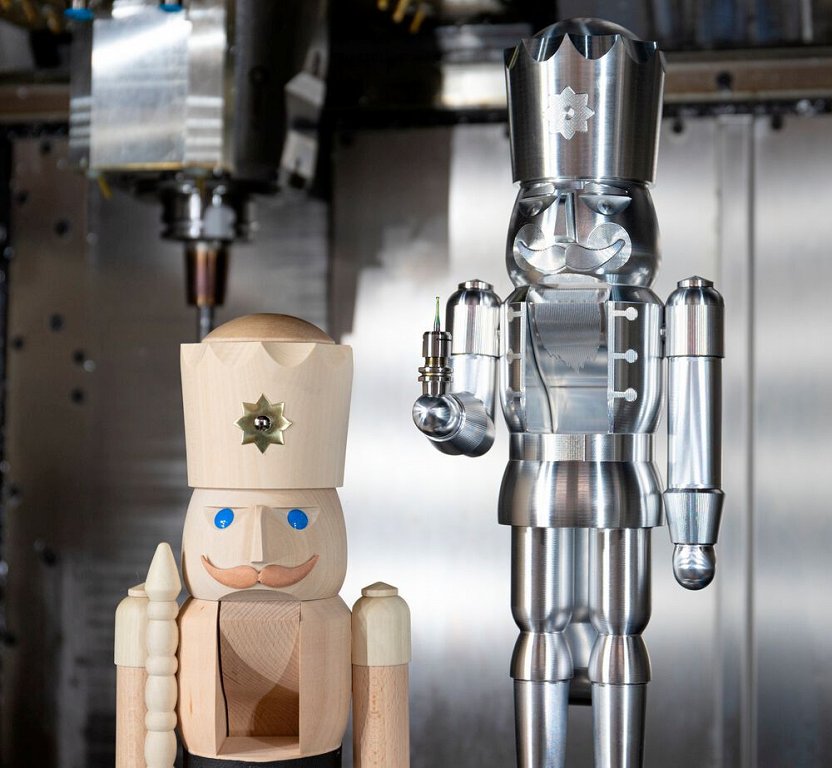Innovation meets tradition — CNC milled nutcracker
24.01.2024
In the run-up to Christmas, Open Mind is showing how an exact replica of the world-famous nutcracker from the Ore Mountains is milled from aluminium. The example demonstrates an end-to-end digital process chain and efficient 5-axis machining with Hypermill.

Foto: Open Mind
Together with Emuge-Franken, CAD/CAM manufacturer Open Mind set itself a task: a 40-centimetre nutcracker was to be digitally reproduced as accurately as possible and milled from aluminium as efficiently as possible. The traditional Seiffener Volkskunst provided the wooden figure, which was handcrafted in around 150 steps and consists of around thirty individual parts.
From scan to surface model
Open Mind turned to Westcam for the 3D scan of the nutcracker. The Austrian partner is not only characterised by its Hypermill expertise, but also has extensive know-how in 3D measurement technology. The result of the scan was a high-resolution mesh model consisting of 1.2 million triangles. At Open Mind, a surface-based 3D model was created using the Hypermill CAD/CAM solution and designed completely parametrically. The advantage of the latter is that production-related changes to the model can be made very easily afterwards. For production, the nutcracker model was divided into the upper part, legs, arms and lever, which were pinned and glued together after completion.
Roughing and residual material processing
Production was carried out at Franken's Rückersdorf application centre on a Hermle C32 in a single clamping operation using 5-axis and 5-axis simultaneous machining. This allowed the surfaces to be machined continuously without segmentation. The opening cut for the large centre pocket of the upper body was efficiently achieved with 5-axis helical drilling, which not only enables a particularly high level of material removal, but is also gentler on the tool than a helical plunge movement. Strategies from the Hypermill Maxx Machining high-performance package were used for further roughing operations. The 5-axis residual material machining function then ensured that the roughing work was completed safely and efficiently. It makes programming easier thanks to automatic setting determination. The new Evogrip centric clamp from Emuge was used for workpiece clamping. With its modular and slim system design, reliable clamping was guaranteed.
Finishing with circular segment milling cutter
The high-precision surface mode was used for finishing, in which Hypermill generates tool paths on the real CAD surfaces and not on a calculation model. The large surfaces of the nutcracker, which are curved in two directions, lent themselves to the use of Franken's circular segment cutters in various shapes: Cone and teardrop shapes with cutting radii from 200 mm to 1,000 mm. The tools, also known as barrel cutters, enable particularly efficient production of high-quality surfaces despite large infeeds or large line jumps. Hypermill offers optimum control of the cutting area of circular segment cutters.
Simulation and optimisation in the virtual machine
“With the nutcracker machining example, we had the problem that the component dimensions were actually already too large for the machining area of the machine — a challenge that many manufacturers have already faced,” explains Michael Förster, Senior Product Marketing Manager at Open Mind Technologies. “What would normally require many manual adjustments and individual simulations to avoid limit switch overshoots and find safe positions can now be realised quickly and reliably thanks to the virtual machine and NC code-based simulation.”
The Hypermill Virtual Machining package includes an optimiser that perfectly adapts the connecting movements between the individual milling operations to the kinematics of the machine and can therefore solve limit switch problems. Communication between the milling centre and the software, which contains a digital twin of the machine, allows precise simulation of machining based on the actual NC code.
Source: ETMM




































